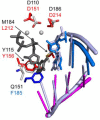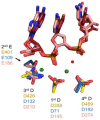Reverse Transcription in the Saccharomyces cerevisiae Long-Terminal Repeat Retrotransposon Ty3
- PMID: 28294975
- PMCID: PMC5371799
- DOI: 10.3390/v9030044
Reverse Transcription in the Saccharomyces cerevisiae Long-Terminal Repeat Retrotransposon Ty3
Abstract
Converting the single-stranded retroviral RNA into integration-competent double-stranded DNA is achieved through a multi-step process mediated by the virus-coded reverse transcriptase (RT). With the exception that it is restricted to an intracellular life cycle, replication of the Saccharomyces cerevisiae long terminal repeat (LTR)-retrotransposon Ty3 genome is guided by equivalent events that, while generally similar, show many unique and subtle differences relative to the retroviral counterparts. Until only recently, our knowledge of RT structure and function was guided by a vast body of literature on the human immunodeficiency virus (HIV) enzyme. Although the recently-solved structure of Ty3 RT in the presence of an RNA/DNA hybrid adds little in terms of novelty to the mechanistic basis underlying DNA polymerase and ribonuclease H activity, it highlights quite remarkable topological differences between retroviral and LTR-retrotransposon RTs. The theme of overall similarity but distinct differences extends to the priming mechanisms used by Ty3 RT to initiate (-) and (+) strand DNA synthesis. The unique structural organization of the retrotransposon enzyme and interaction with its nucleic acid substrates, with emphasis on polypurine tract (PPT)-primed initiation of (+) strand synthesis, is the subject of this review.
Keywords: DNA polymerase; Ty3; retroelement; retrotransposon; reverse transcriptase; reverse transcription; ribonuclease H (RNase H).
Conflict of interest statement
The authors declare no conflict of interest. The funding sponsors had no role in the design of the study; in the collection, analyses, or interpretation of data; in the writing of the manuscript, and in the decision to publish the results.
Figures








Similar articles
-
Ty3 reverse transcriptase complexed with an RNA-DNA hybrid shows structural and functional asymmetry.Nat Struct Mol Biol. 2014 Apr;21(4):389-96. doi: 10.1038/nsmb.2785. Epub 2014 Mar 9. Nat Struct Mol Biol. 2014. PMID: 24608367 Free PMC article.
-
Nonpolar thymine isosteres in the Ty3 polypurine tract DNA template modulate processing and provide a model for its recognition by Ty3 reverse transcriptase.J Biol Chem. 2003 Jul 18;278(29):26526-32. doi: 10.1074/jbc.M302374200. Epub 2003 Apr 30. J Biol Chem. 2003. PMID: 12730227
-
Interaction of the Ty3 reverse transcriptase thumb subdomain with template-primer.J Biol Chem. 2005 Aug 26;280(34):30282-90. doi: 10.1074/jbc.M502457200. Epub 2005 Jun 7. J Biol Chem. 2005. PMID: 15944162
-
Determinants of Genomic RNA Encapsidation in the Saccharomyces cerevisiae Long Terminal Repeat Retrotransposons Ty1 and Ty3.Viruses. 2016 Jul 14;8(7):193. doi: 10.3390/v8070193. Viruses. 2016. PMID: 27428991 Free PMC article. Review.
-
Reverse transcription of retroviruses and LTR retrotransposons.Cell Mol Life Sci. 2001 Aug;58(9):1246-62. doi: 10.1007/PL00000937. Cell Mol Life Sci. 2001. PMID: 11577982 Free PMC article. Review.
Cited by
-
Becoming a Selfish Clan: Recombination Associated to Reverse-Transcription in LTR Retrotransposons.Genome Biol Evol. 2019 Dec 1;11(12):3382-3392. doi: 10.1093/gbe/evz255. Genome Biol Evol. 2019. PMID: 31755923 Free PMC article. Review.
-
A high-quality reference genome for the fission yeast Schizosaccharomyces osmophilus.G3 (Bethesda). 2023 Apr 11;13(4):jkad028. doi: 10.1093/g3journal/jkad028. G3 (Bethesda). 2023. PMID: 36748990 Free PMC article.
-
DARTS: An Algorithm for Domain-Associated Retrotransposon Search in Genome Assemblies.Genes (Basel). 2021 Dec 21;13(1):9. doi: 10.3390/genes13010009. Genes (Basel). 2021. PMID: 35052350 Free PMC article.
-
Yeast for virus research.Microb Cell. 2017 Sep 18;4(10):311-330. doi: 10.15698/mic2017.10.592. Microb Cell. 2017. PMID: 29082230 Free PMC article. Review.
References
-
- Telesnitsky A., Goff S.P. Reverse transcriptase and the generation of retroviral DNA. In: Coffin J.M., Hughes S.H., Varmus H.E., editors. Retroviruses. Cold Spring Harbor Laboratory Press; Cold Spring Harbor, NY, USA: 1997. pp. 121–160. - PubMed
-
- Nowak E., Potrzebowski W., Konarev P.V., Rausch J.W., Bona M.K., Svergun D.I., Bujnicki J.M., Le Grice S.F., Nowotny M. Structural analysis of monomeric retroviral reverse transcriptase in complex with an RNA/DNA hybrid. Nucleic Acids Res. 2013;41:3874–3887. doi: 10.1093/nar/gkt053. - DOI - PMC - PubMed
Publication types
MeSH terms
Substances
LinkOut - more resources
Full Text Sources
Other Literature Sources
Molecular Biology Databases

